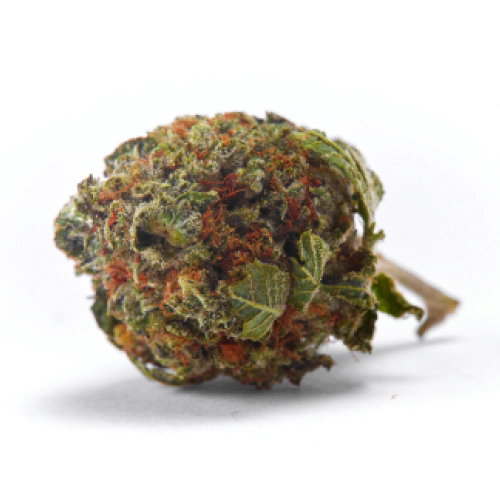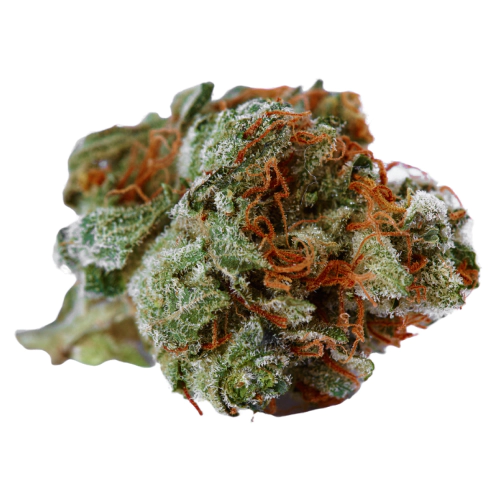THC 18 - 25%
CBD 0.05 - 0.27%
Effect Concentrated
Flavor Chestnut
14.5 - 15%
2.75 - 2.85%
0.07 - 0.09%
Lemon, Citrus
Giggly
The Glacier Glue strain is a rare Indica-leaning hybrid (60% Indica/40% Sativa). This cannabis flower was created by crossing the classic Glacier OG with the popular Gorilla Glue #4 strains. The flavor and aroma of the Glacier Glue are spicy with distinct herbal undertones that are complemented by a diesel-like taste with a flowery citrus aftertaste. This delicious flavor palette is a result of limonene and humulene as the dominant terpenes. The Glacier Glue marijuana bud produces a high that has a light creeping effect. Every exhale will slowly build in the back of your mind making you feel uplifted, happy and giggling. With a medium THC level amounting to 14.5-15%, the Glacier Glue weed might be a good choice for beginners but still require proper preparation.
Alongside THC, the cannabinoid content is also made up of compounds including:
The Glacier Glue strain has a spicy aroma with an earthy grape overtone that turns sweet and savory with hints of diesel and lemon with every exhale. The taste of this weed is pretty similar but more complex, allowing smokers to notice various berry hints with apricot, flowery, and mint as a fresh finish. The terpene composition is dominated by limonene that is responsible for the lemon citrus aftertaste. The second prevalent terpene is humulene, which gives the Glacier Glue cannabis flower peppery and earthy hints you can expect from marijuana. Other terpenes create a varied composition and include:
Combining effects from both Indica and Sativa, the Glacier Glue high is mainly uplifting. The euphoria starts with the head buzz that provides mental clarity and then energizes the body, keeping you on the go. Once the mind settles down, you can achieve a bliss of happiness and giggle at everything around you. Boasting relieving properties, the Glacier Glue strain then promotes hazy relaxing effects that will fill both mind and body before launching you into a state of heavy sedation that often ends in sleep. Some smokers admit that this cannabis flower made them hungry and aroused.
Due to this bouquet of effects and rich THC content, Glacier Glue marijuana is often chosen to cope with symptoms of the following health issues:
Among the most common adverse reactions when smoking this weed is thirst and dry mouth, which is pretty classic for cannabis.
Known for its high yields, the Glacier Glue marijuana strain can produce 10-15 ounces per plant. The weed is better for outdoor growing, where it can reach up to 80 inches, while indoors, the maximum height is 60 inches. Growers can expect yield in 57 days, having a flowering time of 54-63 days. Glacier Glue produces buds that have fluffy rounded popcorn-shaped dusty green nugs and are covered with a thin layer of dark amber hairs that are also completely coated in luxe milk crystal trichomes and sweet sticky resin.
| THC | Tetrahydrocannabinol, or THC, is a major cannabis chemical compound. It is a psychoactive element that stimulates dopamine release and induces euphoria or happiness. THC-rich strains may be helpful with such conditions as lack of appetite, chronic pains , etc. It is considered to be the primary active marijuana component. | 14.5 - 15% |
| CBD | Cannabidiol, or CBD, is a major compound in cannabis, which is non-psychoactive. It is also proved to counteract the side effects of the second major component THC. CBD is widely used for medicinal purposes in rubs, oils and so on. It is helpful in muscle pain cases, may treat arthritis and migraines. Even Greeks used it against pain, while Queen Victoria applied it to get rid of menstrual cramps. | 2.75 - 2.85% |
| CBC | Cannabichromene, or CBC, is a minor cannabinoid, meaning that its quantity in cannabis is quite little. Though it has the same origin as CBD and THC, it is different in functions. Without any psychoactive effects, it is an efficient cannabis compound in combating acne and depression. CBC produces analgesic, antibacterial and anti-inflammatory effects. | 0.07 - 0.1% |
| CBG | Cannabigerol, or CBG, is one of the minor cannabis compounds in adult plants. On the other hand, young ones contain a lot of this antibacterial and anti-inflammatory component. During the growth, CBG is converted into different cannabinoids, mostly THC and CBD. The compound itself increases appetite and decreases eye pressure. | 0.07 - 0.09% |
| CBN | Cannabinol, or CBN, is a trace element in cannabis that is considered to be mildly psychoactive. It appears from oxidation THC, exposed to light and heat. CBN is mostly contained in old cannabis and in traditional hashish. It is effective against insomnia, bacterial infections and appetite loss. | 0.32 - 0.41% |
| THCV | Tetrahydrocannabivarin, or THC-V, is a compound contained in cannabis in trace amounts. Even though it is close to THC molecularly, it is different in effects. This compound may be psychoactive only in large amounts. THC-V reduces blood sugar, controls appetite, stimulates bone growth, etc. African Sativa strains are the richest in THC-V. | 0.2 - 0.24% |
| Carene | Carene (also known as Delta-3 carene) is a terpene found in rosemary, lemons, pines, and cedars, offering citrusy and cypress aroma. Studies on mice showed that carene provides anti-inflammatory effects, as well as promotes bone health and chronic pain relief. | 0.04% |
| Pinene | Pinene is one of the most widespread terpenes in nature, found in pine trees, basil, nutmeg, parsley, and rosemary. Cannabis containing terpene (alpha-pinene or α-pinene) boasts a strong pine scent. Pinene is responsible for anti-inflammatory, pain-relieving, and anti-anxiety effects. | 0.07% |
| Camphene | Camphene is terpene common for carrots, pepper, dill, fennel, nutmeg, thyme, as well as other fruits and vegetables. Camphene has a damp, pungent, herbal, minty aroma with pine undertones. In cannabis, mostly found in Indica strains. Camphene causes cooling sensations, having anti-inflammatory, antibiotic, antioxidant, analgesic, and antifungal effects. | 0.11% |
| Humulene | Humulene (also known as α-humulene) is one of the major terpenes found in cannabis, contributing to woody, earthy, spicy, herbaceous, and, mainly, floral aromas of cannabis. Used in modern medicine, humulene offers anti-inflammatory, antibacterial, and appetite suppressant effects, which have been well-researched by pharmaceutical companies. | 0.14% |
| Limonene | Limonene (also known as d-limonene) is the second most common terpene in nature and the third most common terpene in cannabis. It has a powerful citrus aroma and can be found in all citruses, including lemons, oranges, grapefruits, limes, juniper, etc. Limonene is known to elevate moods and provide anxiety, depression, and stress relief. | 0.33% |
| Linalool | Linalool (also known as beta linalool, linalyl alcohol, linaloyl oxide, and p-linalool) is one of the rarest terpenes found in cannabis, mostly in small quantities. Linalool is known for its spicy and lavender aroma, bringing relaxation and calming effects. It is also said to provide anti-inflammatory and analgesic properties that can be useful for athletes. | 0.06% |
| Bisabolol | Bisabolol (also known as α-Bisabolol or levomenol) is a lesser-known terpene found in cannabis. It contributes to anti-inflammatory, anti-irritant, antioxidant, anti-microbial, and analgesic properties of weed strains containing bisanol. Attentive smokers would be able to catch a nutty, fruity scent with herbal and floral undertones, with a tender trace of coconut. | 0.12% |
| Valencene | Valencene is a terpene that got its name from Valencia oranges - a fruit where It's initially found. Valencene offers citrusy, sweet aromas, with flavors having notes of oranges, grapefruits, tangerines, and, occasionally, fresh herbs or freshly cut wood. Citrus aromas, frequently found in a wide variety of cannabis strains, are contributed to by valencene, which is known for anti-inflammatory and insect repelling properties. | 0.06% |
| Caryophyllene | Caryophyllene (also known as beta or b caryophyllene) is a terpene found in many herbs and spices, such as black pepper, basil, rosemary, and oregano. Cannabis high in caryophyllene delivers a strong spicy, peppery aroma, resembling cinnamon and cloves. Caryophyllene offers potent anti-inflammatory and sedative effects. | 0.07% |
| Total terpenes content | 1.00% |
THC 18 - 25%
CBD 0.05 - 0.27%
Effect Concentrated
Flavor Chestnut

THC 21.4 - 23.8%
CBD 0.35 - 0.82%
Effect Concentrated
Flavor Pine
THC 18 - 21.5%
CBD 1.28 - 1.57%
Effect Sleepy
Flavor Sweet
THC 15 - 9.5%
CBD 10.52 - 12.27%
Effect Uplifted
Flavor Ammonia
THC 14 - 17%
CBD 0.05 - 0.75%
Effect Creative
Flavor Apricot
THC 19.5 - 21.67%
CBD 0.54 - 0.87%
Effect Euphoric
Flavor Sweet
THC 11.99 - 12.01%
CBD 0.58 - 0.83%
Effect Happy
Flavor Ammonia
THC 25.33 - 29%
CBD 0.42 - 0.75%
Effect Uplifted
Flavor Spicyherbal
THC 17 - 18%
CBD 0.71 - 0.95%
Effect Aroused
Flavor Sage

THC 21.5 - 24.5%
CBD 0.53 - 0.86%
Effect Sleepy
Flavor Lemon
THC 24.67 - 27.67%
CBD 0.3 - 0.48%
Effect Relaxed
Flavor Sweet
THC 17.88 - 17.38%
CBD 0.21 - 0.43%
Effect Talkative
Flavor Spicyherbal

THC 17 - 20.33%
CBD 0.14 - 0.3%
Effect Sleepy
Flavor Skunk
Be the first and share your opinion
Write a Review